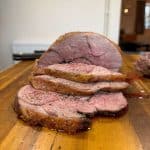Slow Roasted Leg Of Lamb (Reverse Seared)
Here's how to cook a slow roasted leg of lamb that's perfectly pink, tender & full of flavour. We've removed part of the leg bone as well, to make our roast lamb easier to carve!
Servings: 10 People
Equipment
- Small Mixing Bowl
- Boning Knife
- Butcher's Twine
- Roasting Tin With Rack
- Digital Food Probe
Ingredients
- 2½ - 3 kg Bone In Leg Of Lamb (See Notes)
Garlic & Rosemary Marinade
- 2 tsp Finely Chopped Rosemary
- 4 Garlic Cloves (Grated)
- Zest Of 1 Lemon
- 1 tbsp Olive Oil (Plus Extra For Cooking)
Instructions
Garlic & Rosemary Marinade
- Add the rosemary, garlic, oil & lemon zest into a small mixing bowl, season well with sea salt & freshly cracked black pepper then stir to combine. Set this aside for now.
Deboning & Rolling The Lamb
- Pat the meat dry with kitchen paper then set the leg of lamb onto a large cutting board so that it's facing skin/fat side down & the shank is facing away from you. Use your fingers to feel where the bone is running through the bottom part of the leg.
- Using a sharp boning knife, cut straight through the meat in the bottom part of the leg until you reach the bone. Make sure not to cut into the shank though, as we're leaving the top part of the bone in the leg.There's a visual guide to removing the bone in the post above! The bone runs in a pretty straight line but don't worry if misjudge your cut slightly as we're going to be butterflying the meat anyway!
- Use the tip of your knife to carefully cut the meat away from the top & sides of the bone, cutting away small sections at a time. Work your way up the bone towards the knee joint & shank.
- Once you've cut enough meat away from around the bone, you'll be able to get the tip of your knife underneath, to cut the meat away from the bottom part of the bone as well. Keep working your way up & around the bone until you reach the top of the bone, where it connects at the knee joint.At this point, the bone will be free from the leg meat but still attached at the joint.
- Bend the leg bone up towards the shank, to open up the joint then cut between the 2 bones (through the joint) & around the top of the leg bone, to release it.You can use the leg bone for stocks & gravy!
- Trim any bits of bone, cartilage or big chunks of fat from inside the leg then butterfly the meat on either side of where the bone was, making sure not to cut all the way through the meat.
- Next, lightly score the meat inside the leg in a criss cross pattern then spoon over the marinade & massage into the meat.
- Fold the meat back together, to its' original position then flip the leg over so that it's facing skin side up. Tie the boneless portion of the leg up with butcher's twine, to secure, leaving a couple of centimetres between each piece then let the lamb sit uncovered in the fridge overnight.
Slow Roasting
- Take your lamb out of the fridge, place onto a rack set inside a roasting tin then let the meat sit at room temperature for 1 hour.The lamb should be sitting fat/skin side up.
- In the meantime, preheat an oven to 120°c/100°c fan (248°f/212°f).
- Next, brush the outside of the lamb with a light layer of olive oil then season generously with sea salt & freshly cracked black pepper.
- Place the lamb into the preheated oven then cook until the internal temperature reaches 55°c/131°f. This will roughly take between 2-3 hours.Check the lamb regularly after 2 hours. Make sure to probe the meat in the centre of the joint.
- Once cooked, take the lamb out of the oven, cover loosely with foil then leave to rest for at least 30 minutes or up to 1 hour.
- Whilst your lamb is resting, turn your oven up as high as it will go. In most oven this will be around 260°c/500°f.
- Once your lamb has rested, remove the foil then cook in the preheated oven for 6-8 minutes, until well seared. The skin should be golden brown & crisp.
- Transfer your lamb to a chopping board, remove any string then cut into slices.
Notes
1. Cooking In An Aga - Slow roast the lamb in the simmering oven, on the second from bottom set of runners. Sear the lamb in the roasting oven. Place your roasting tin as high in the roasting oven as you can, without letting the meat touching the top.
2. Leg Of Lamb - You'll need a whole, bone in leg of lamb for this recipe, which should weigh around 2kg. If you're using one that's slightly bigger or smaller, keep in mind that the cook time will be slightly different. If you'd prefer, your butcher will be able to take the bone out of the leg for you.
3. Internal Temperatures - To cook our lamb medium, we roast it until it reaches 55°c/135°f, let it rest then sear it at a high temperature. We're aiming for a final internal temperature of around 60°c/140°f. Feel free to cook it more if you'd prefer.
4. Resting - Once roasted, the lamb needs to rest for at least 30 minutes before being seared & served. I find that an hour long rest is best. Make sure to cover the lamb loosely in foil!
5. Leftovers - Any leftover lamb should be stored in the fridge & will keep for up to 3 days. Leftovers can be served cold or reheated in the oven (in gravy is best!).
